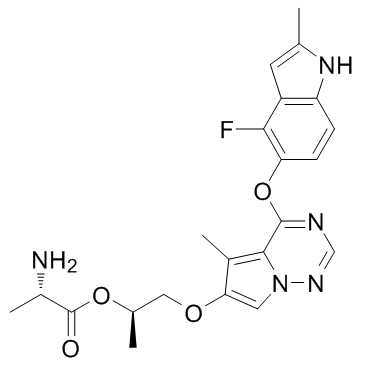Brivanib Alaninate (BMS-582664)
Modify Date: 2024-01-03 06:54:29

Brivanib Alaninate (BMS-582664) structure
|
Common Name | Brivanib Alaninate (BMS-582664) | ||
|---|---|---|---|---|
| CAS Number | 649735-63-7 | Molecular Weight | 441.456 | |
| Density | 1.4±0.1 g/cm3 | Boiling Point | N/A | |
| Molecular Formula | C22H24FN5O4 | Melting Point | N/A | |
| MSDS | N/A | Flash Point | N/A | |
Use of Brivanib Alaninate (BMS-582664)Brivanib alaninate is an ATP-competitive inhibitor against VEGFR2 with an IC50 of 25 nM; has moderate potency against VEGFR-1 and FGFR-1, but more than 240-fold against PDGFRβ. |
| Name | [(2R)-1-[4-[(4-fluoro-2-methyl-1H-indol-5-yl)oxy]-5-methylpyrrolo[2,1-f][1,2,4]triazin-6-yl]oxypropan-2-yl] (2S)-2-aminopropanoate |
|---|---|
| Synonym | More Synonyms |
| Description | Brivanib alaninate is an ATP-competitive inhibitor against VEGFR2 with an IC50 of 25 nM; has moderate potency against VEGFR-1 and FGFR-1, but more than 240-fold against PDGFRβ. |
|---|---|
| Related Catalog | |
| Target |
VEGFR2:25 nM (IC50) |
| In Vitro | Brivanib inhibits VEGFR1 and FGFR-1 with IC50 of 0.38 μM and 0.148 μM. Brivanib is not sensitive to PDGFRβ, EGFR, LCK, PKCα or JAK-3 with IC50 all above 1900 nM. Brivanib could inhibit the proliferation of VEGF-stimulated HUVECs with IC50 of 40 nM, compared to 276 nM in FGF-stimulated HUVECs. On the other hand, brivanib exhibits low activity to tumor cell lines[1]. Brivanib doses ≤20 µM paradoxically enhances FGF-induced LX-2 cell proliferation, whereas higher brivanib doses (≥30 µM) inhibits LX-2 cell proliferation. The inhibitory effect of brivanib on liver fibrosis is not through inhibition of TGF-β 1-induced stellate cell activation, and is possibly through inhibition of PDGF-BB-induced stellate cell activation[3]. |
| In Vivo | Brivanib displays antitumor activities in H3396 xenograft in athymic mice. At a dose of 60 and 90 mg/kg (p.o.), brivanib completely inhibits the tumor growth, with TGI of 85% and 97%, respectively[1]. Moreover, brivanib significantly suppresses tumor growth in Hepatocellular carcinoma (HCC) xenografts, which due to the decrease in phosphorylation of VEGFR2. The results show that the tumor weights in 06-0606 xenograft mice are 55% and 13%, compared with the controls at a dose of 50 mg/kg and 100 mg/kg. Brivanib is suggested to be efficient in treatment of HCC[2]. Brivanib (50 mg/kg, p.o.) attenuates liver fibrosis and stellate cell activation induced by BDL in mice. Brivanib inhibits growth factor and growth factor receptor mRNA expression in sham control animals but shows variable effects in bile duct ligated animals[3]. |
| Cell Assay | Viability is measured in LX-2 cells using the Cell Counting Kit-8 (CCK-8). Using 96-well plates with 2,000 cells per well, HSCs are incubated in 10% FBS-supplemented DMEM for 24 hours, followed by starvation in serum-free media. After 24 hours of starvation, brivanib is added at different doses. Two hours later, 5 ng/mL PDGF-BB is added. The cells are incubated for an additional 72 hours and cell viability is measured. Each experiment is performed in three replicates at least four times[3]. |
| Animal Admin | Male mice 4-6 weeks of age are treated 3 times a week with a total of 12 intraperitoneal (i.p.) injections of 150 mL/kg TAA. At the onset of TAA treatment, placebo or brivanib (25 or 50 mg/kg) is administered orally on 5 consecutive days with weekend breaks. The animals are sacrificed 4 weeks after the start of the injections[3]. |
| References |
| Density | 1.4±0.1 g/cm3 |
|---|---|
| Molecular Formula | C22H24FN5O4 |
| Molecular Weight | 441.456 |
| Exact Mass | 441.181244 |
| PSA | 116.76000 |
| LogP | 2.27 |
| Index of Refraction | 1.648 |
| Storage condition | -20°C |
| HS Code | 2933990090 |
|---|
| Precursor 1 | |
|---|---|
| DownStream 0 | |
| HS Code | 2933990090 |
|---|---|
| Summary | 2933990090. heterocyclic compounds with nitrogen hetero-atom(s) only. VAT:17.0%. Tax rebate rate:13.0%. . MFN tariff:6.5%. General tariff:20.0% |
| L-Alanine, (1R)-2-[[4-[(4-fluoro-2-methyl-1H-indol-5-yl)oxy]-5-methylpyrrolo[2,1-f][1,2,4]triazin-6-yl]oxy]-1-methylethyl ester |
| Brivanib L-alanine ester |
| Brivanib alaninate |
| (2R)-1-({4-[(4-fluoro-2-methyl-1H-indol-5-yl)oxy]-5-methylpyrrolo[2,1-f][1,2,4]triazin-6-yl}oxy)propan-2-yl L-alaninate |
| (2R)-1-({4-[(4-Fluoro-2-methyl-1H-indol-5-yl)oxy]-5-methylpyrrolo[2,1-f][1,2,4]triazin-6-yl}oxy)-2-propanyl L-alaninate |
| cc-420 |
| 1-[[4-[(4--2--1H--5-)]-5-[2,1-F][1,2,4]-6-]]-2-L |
| BMS-582664 |
| Brivanib (alaninate) |
![(R)-1-((4-((4-fluoro-2-methyl-1H-indol-5-yl)oxy)-5-methylpyrrolo[2,1-f][1,2,4]triazin-6-yl)oxy)propan-2-yl ((benzyloxy)carbonyl)-L-alaninate structure](https://image.chemsrc.com/caspic/122/649736-41-4.png)